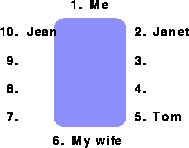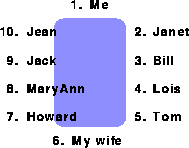x = yMultiplying each side by x
x2 = xySubtracting y2 from each side
x2 - y2 = xy - y2Factoring each side
(x + y)(x - y) = y (x - y)Dividing out the common term ((x - y) we have
x + y = ySubstituting the given values
1 + 1 = 1Or
2 = 1What is wrong with this proof?
Solution :
There was nothing wrong up through line
(x + y)(x - y) = y (x - y)If we substitute the values of x and y we have
(2)(0) = (1)(0)or
0 = 0However, when we divide both sides by (x - y), we break a fundamental rule of mathematics that we cannot divide out by a fraction which is equal to zero.
2. My daughter is twice as old as my son and half as old as I am. In twenty-two years my son will be half my age. How old is my daughter?
Solution :
Let us assume my daughter is age x. We are told my daughter is twice as old as my son, so that my son must be age x/2. We are also told that I am twice as old as my daughter so my age is 2x. In 22 years time my son will be (x/2 + 22) and I will be (2x + 22). Since he will be half of my age at that time,
x/2 + 22 = 1/2 (2x+22)Multiplying both sides by 2
x + 44 = 2x + 22or
x = 22My daughter is 22 years old.
3. Aspirin does wonders for my headache and helps my rheumatic knee but it gives me nausea and upsets my stomach. Herbal medicine cures my nausea and stomach upset but gives me hip pain. Antibiotics sooth my headache and nausea but irritate my stomach and knee and give me a stiff neck. Cortisone helps my stiff neck and rheumatic knee but aggravates my hip condition. Hot compresses work wonders for my upset stomach and stiff neck. I woke up today with a pounding headache which prevents me from figuring out how best to doctor myself. What do you think I should do?
Solution :
I advise you to take aspirin and antibiotics and to apply hot compresses to your neck. Aspirin relieves the headache but gives you nausea and upsets your stomach; the antibiotics relieve the nausea but add pains to your knee and give you a stiff neck. The knee is taken care of by the aspirin. As far as the upset stomach and the stiff neck are concerned, the hot compresses will take care of them.
4. We were given a formal dinner party for ten (including ourselves) which is a number I always like because the host can sit at one end of the table and the hostess at the other, and still maintain the correct alternate male and female around the table. My wife was trying to work out the seating. "Tom and Jean have not been here to dinner before so they are the guests of honor. Tom must sit on my right and Jean on your right, but I don't know how I want to seat the others.: "Well," I said, "I would like Janet on my left. I have a soft spot for her." "You can have her," replied my wife, "but I will not have her husband Jack next to me; I think he should be next to Mary Ann."
Since we do not place husbands and wives next to each other, this determined the seating of everyone, including Howard's wife Lois, and Mary Ann's husband Bill. Can you work out the seating arrangement?
Solution :
Numbering the ten places around the table 1 to 10 as shown in the figure below, if I take the head of the table (1), my wife will sit at (6), Jean will be at (10), Tom at (5), and Janet at (2).

Now my wife will not have Jack next to her so he must be at (9), because (3) would place him next to his wife. Since Mary Ann is next to Jack, she must be at (8); then Howard must be at (7), Bill at (3), and Lois at (4).

5. Think of a number between 1 and 26. Look at the following table of six squares, one square at a time.
+----------+----------+----------+ | 1 4 7 | 2 5 8 | 3 4 5 | | 10 13 16 | 11 14 17 | 12 13 14 | | 19 22 25 | 20 23 26 | 21 22 23 | +----------+----------+----------+ | 6 7 8 | 9 10 11 | 18 19 20 | | 15 16 17 | 12 13 14 | 21 22 23 | | 24 25 26 | 15 16 17 | 24 25 26 | +----------+----------+----------+Each time the number you have picked belongs to one of the squares, write down the number in the top left-hand corner. Add together all these numbers. For example, 16 is in the first, fourth, and fifth squares. If the first numbers of each of these squares are added together, we get 1 + 6 + 9 = 16, which is the original number we picked. Can you explain this?
Solution :
Any number n equal to or smaller than 26 must certainly be smaller than 33 = 27. It can therefore be broken down (in base 3) in the following manner:
n = (0 or 1 or 2) x 30 + (0 or 1 or 2) x 31 + (0 or 1 or 2) x 32In other words
n = (0 or 1 or 2) + (0 or 3 or 6) + (0 or 9 or 18)Thus all number that have a "1" in their makeup will be found in the first square, all number that have a "2" in the second square, a "3" in the third square, a "6" in the fourth square, a "9" in the fifth, and an "18" in the sixth. The number n can therefore be found by adding the numbers at the top left-hand corner of the squares where n appears.
No comments:
Post a Comment